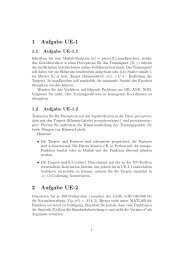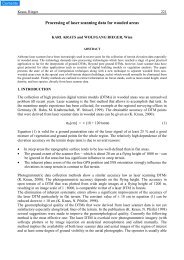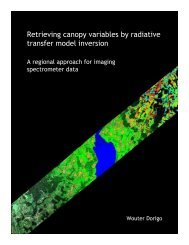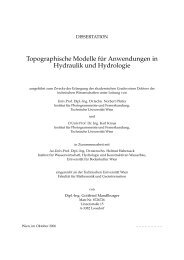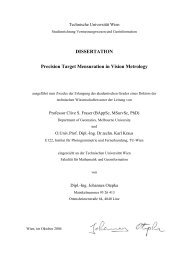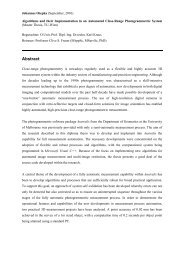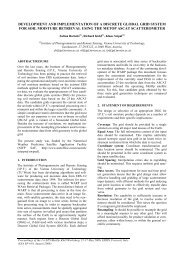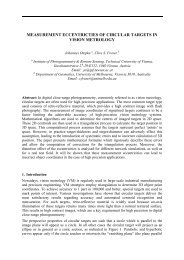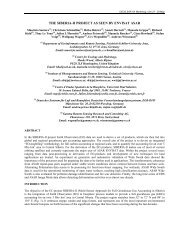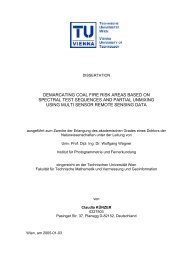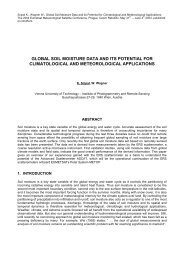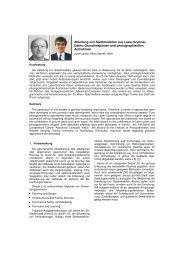Soil Moisture Products from C-band Scatterometers - Institute of ...
Soil Moisture Products from C-band Scatterometers - Institute of ...
Soil Moisture Products from C-band Scatterometers - Institute of ...
You also want an ePaper? Increase the reach of your titles
YUMPU automatically turns print PDFs into web optimized ePapers that Google loves.
1<br />
SOIL MOISTURE PRODUCTS FROM C-BAND SCATTEROMETERS: FROM ERS-1/2 TO METOP<br />
Zoltan Bartalis, Klaus Scipal, Wolfgang Wagner<br />
I.P.F. - Insitute <strong>of</strong> Photogrammetry and Remote Sensing, Vienna University <strong>of</strong> Technology, Austria<br />
ABSTRACT<br />
Based on ERS-1/2 scatterometer data <strong>from</strong> 1992 to 2000,<br />
work carried out at the <strong>Institute</strong> <strong>of</strong> Photogrammetry and<br />
Remote Sensing (Vienna University <strong>of</strong> Technology) resulted<br />
in a multi-year, global, remotely sensed soil moisture<br />
dataset. An exciting aspect <strong>of</strong> these developments<br />
is that the ERS scatterometer instrument finds an operational<br />
continuation in ASCAT, the Advanced Scatterometer<br />
onboard the upcoming series <strong>of</strong> MetOp satellites.<br />
This paper describes the conditions <strong>of</strong> applying the soil<br />
moisture retrieval methods to future ASCAT data, thus<br />
turning the global soil moisture dataset into an important<br />
operational, long-term, near real-time, continuous<br />
and consistent resource serving the hydrometeorological,<br />
agricultural and climatological communities. Differences<br />
between the two instruments are reviewed, pointing out<br />
their possible impact on the measurement characteristics<br />
and the resulting soil moisture data.<br />
Key words: ERS, ASCAT, MetOp, scatterometer, soil<br />
moisture.<br />
1. INTRODUCTION<br />
Retrieval <strong>of</strong> soil moisture is still considered an open issue<br />
and is presently the subject <strong>of</strong> extensive research.<br />
This missing parameter is an important state variable <strong>of</strong><br />
the global energy and water and an important boundary<br />
condition for our climate system (Ref. 1). Along<br />
with snow cover, it is also the most important component<br />
<strong>of</strong> meteorological memory for the climate system<br />
over land (Ref. 2). Apart <strong>from</strong> its dominant role in the<br />
global climate system, soil moisture takes a fundamental<br />
role in climate-sensitive socio-economic activities like<br />
water management, agriculture or flood and drought hazards<br />
monitoring. Knowledge <strong>of</strong> the soil moisture state<br />
and its spatial and temporal dynamics is therefore essential<br />
for meteorological, climatological, hydrological and<br />
agronomy applications. Its importance is reflected in the<br />
present preparations for two dedicated space missions:<br />
SMOS (<strong>Soil</strong> <strong>Moisture</strong> and Ocean Salinity) by ESA with<br />
launch scheduled in 2007 and HYDROS by NASA, in<br />
2009. Both these missions focus on passive radar techniques<br />
for soil moisture retrieval, due to better penetration<br />
depth at L-<strong>band</strong> frequencies and the better existing<br />
soil roughness modelling capabilities. However, advances<br />
in active radar techniques particularly at C-<strong>band</strong><br />
frequencies have shown the potential <strong>of</strong> spaceborne scatterometers<br />
to retrieve top-soil moisture (Ref. 3). The developed<br />
methods (referred to as the Vienna University <strong>of</strong><br />
Technology – VUT – model) applied to data <strong>from</strong> the<br />
ERS 1/2 scatterometers have resulted in the first global,<br />
remotely sensed soil moisture dataset. The data compares<br />
well to in-situ measurements and its quality has<br />
been found to be comparable to that <strong>of</strong> state-<strong>of</strong>-the-art<br />
modelled products. Its accuracy has been found to be<br />
around 0.05 m 3 /m 3 . The similar ASCAT scatterometer<br />
onboard the upcoming MetOp series <strong>of</strong> satellites <strong>of</strong>fers<br />
now the possibility <strong>of</strong> an operational continuation <strong>of</strong> this<br />
soil moisture dataset.<br />
In the present paper the conditions <strong>of</strong> applying the ERS<br />
soil moisture retrieval methods to future ASCAT data are<br />
outlined, with the aim <strong>of</strong> turning the global soil moisture<br />
dataset into an important operational, long-term, near<br />
real-time, continuous and consistent resource with many<br />
future hydrometeorological, agricultural and climatological<br />
applications. The differences between the two instruments<br />
are presented and their influence the retrieval<br />
process are discussed.<br />
2. C-BAND SCATTEROMETER SOIL MOIS-<br />
TURE<br />
The VUT-model is based on a change detection algorithm<br />
tailored to the sensor characteristics <strong>of</strong> the ERS Scatterometer.<br />
The algorithm exploits the multiple incidence<br />
angle viewing capabilities <strong>of</strong> the sensor in order to separate<br />
soil moisture and vegetation effects.<br />
By applying the algorithm separately to time series in a<br />
predefined global grid, characteristic model parameters<br />
are derived. Unlike the case <strong>of</strong> more complex theoretical<br />
or semi-empirical approaches <strong>of</strong>ten preferred for retrieval<br />
purposes, these parameters describe the unique environmental<br />
conditions and account naturally for the effects<br />
<strong>of</strong> heterogeneous land cover and surface roughness.<br />
The change detection method indirectly accounts for surface<br />
roughness effects, since at the spatial scale <strong>of</strong> the<br />
C-<strong>band</strong> scatterometer (tens <strong>of</strong> kilometres), surface roughness<br />
changes due to farming activities or other effects can
2<br />
be assumed to have negligible effects on the time series<br />
recorded by the scatterometer. Similarly, the method accounts<br />
also for heterogeneous land cover since many land<br />
cover classes such as forests, dense shrubs, urban areas<br />
and small inland water bodies are characterised by relatively<br />
stable C-<strong>band</strong> backscatter values and hence do not<br />
need to be separately modelled.<br />
The model considers vegetation growth and decay over<br />
grassland and agricultural regions since this may cause<br />
backscatter to change by several decibels. In these areas,<br />
the seasonal increase in biomass has thus its own contribution<br />
to the backscatter which must be eliminated to uphold<br />
the relationship between backscatter and soil moisture.<br />
In order to do so, the seasonal change <strong>of</strong> the relationship<br />
between backscatter and incidence angle is modelled,<br />
making it possible to statistically estimate typical<br />
wet and dry condition backscatter signatures for different<br />
periods <strong>of</strong> the phenological cycle (see Fig. 1). Using<br />
these signatures, vegetation effects are corrected for and<br />
time series <strong>of</strong> the topsoil moisture content are obtained,<br />
ranging <strong>from</strong> the typically driest values to the typically<br />
wettest ones. In order to allow a comparison with soil<br />
moisture measurements over greater depths (up to about<br />
one meter) a two-layer water balance model, which only<br />
considers the exchange <strong>of</strong> soil water between the topmost<br />
remotely sensed layer and the ’reservoir’ below, was used<br />
to establish a relationship between the topsoil series and<br />
the pr<strong>of</strong>ile soil moisture content (Ref. 3). The water content<br />
in the soil pr<strong>of</strong>ile is estimated by convoluting the surface<br />
soil moisture series with an exponential filter.<br />
3. TRANSITION FROM ERS TO METOP AND<br />
SOIL MOISTURE DATA CONTINUITY<br />
The advanced scatterometer (ASCAT) on board the meteorological<br />
operational (MetOp) platforms is the followon<br />
for European scatterometers (Ref. 4). ASCAT will be<br />
part <strong>of</strong> EUMETSAT’s Polar System (EPS) and will be<br />
nearly identical to the ERS scatterometer. It is designated<br />
to be an operational system with the intention to ensure<br />
data continuity over an initial period <strong>of</strong> at least 14 years,<br />
starting in 2005.<br />
In principle, the VUT-model developed for the ERS Scatterometer<br />
should be directly applicable to ASCAT data.<br />
Since the methods involve statistically determining typical<br />
minima and maxima, applying them exclusively to<br />
the new ASCAT data would start yielding reliable results<br />
only after approximately 3 years. Given the fact that the<br />
statistical parameters in question have already been determined<br />
using ERS data, retroactive integration <strong>of</strong> the new<br />
data could start already at the beginning <strong>of</strong> the MetOp<br />
mission series. This would result in a valuable soil moisture<br />
dataset with unprecedented continuity and coverage.<br />
Nevertheless, slight differences in the design and operation<br />
<strong>of</strong> the two sensors (see Table 1) oblige a careful<br />
merging <strong>of</strong> measurements, involving accurate characterization<br />
<strong>of</strong> the error properties <strong>of</strong> both time series. The<br />
following points review the influence <strong>of</strong> the different instrument<br />
characteristics on the soil moisture retrieval.<br />
3.1. Temporal Resolution<br />
The ASCAT sensor will use six antennae instead <strong>of</strong> the<br />
three <strong>of</strong> the ERS Scatterometer. This, combined with the<br />
fact that ASCAT will be a dedicated instrument not sharing<br />
operational time with other instruments, will significantly<br />
increase the temporal resolution <strong>of</strong> the backscatter<br />
time series, especially important for areas like Europe<br />
(where SAR operation usually has priority over the scatterometer<br />
onboard ERS) and tropical regions, where the<br />
ERS scatterometer has a too low sampling rate to be able<br />
to detect important rain events. Fig. 2 compares the 2-day<br />
swaths for the two instruments at continuous operation<br />
and Fig. 3 shows the latitude dependency <strong>of</strong> the average<br />
number <strong>of</strong> measurements per area unit. The ASCAT scatterometer<br />
will provide on average <strong>from</strong> 4 to 20 backscatter<br />
triplets per day and 25 km × 25 km area unit, with<br />
approximately double as many measurements at high latitudes.<br />
The increased temporal resolution will benefit the overall<br />
quality <strong>of</strong> the topsoil moisture series and <strong>of</strong> the pr<strong>of</strong>ile<br />
soil moisture in particular. However, different exponential<br />
filters used to model the water content pr<strong>of</strong>ile might<br />
have to be applied to the different portions <strong>of</strong> the total<br />
time series.<br />
3.2. Spatial Resolution<br />
One <strong>of</strong> the improvements <strong>of</strong> the ASCAT sensor in contrast<br />
with the ERS scatterometer is a planned product<br />
with an increased spatial resolution <strong>of</strong> 25 km. It is clear<br />
that in the foreseeable future modellers who have so<br />
far worked with 0.5–2 degree resolution cells will move<br />
more and more towards resolutions comparable to 25 km<br />
because <strong>of</strong> data availability. Recent tests <strong>of</strong> reprocessing<br />
ERS Scatterometer data to a resolution <strong>of</strong> 25 km show<br />
very promising results concerning the separation <strong>of</strong> physically<br />
meaningful details in comparison to the 50 km resolution<br />
product. Figure 4 compares ERS backscatter images<br />
<strong>of</strong> 25 and 50 km resolution over the central-northern<br />
part <strong>of</strong> European Russia. The coniferous forest patterns<br />
<strong>of</strong> the land cover map are clearly more recognizable in<br />
the 25 km product, similarly to the humid grassland and<br />
water areas as well as the contour and location <strong>of</strong> the<br />
strongly ’reflecting’ city <strong>of</strong> Moscow.<br />
A change <strong>of</strong> scale <strong>from</strong> 50 to 25 km resolution could have<br />
an impact on the model itself. Effects such as seasonal<br />
roughness changes due to agriculture (which at the moment<br />
are assumed to be within the noise level) need to be<br />
thoroughly investigated.<br />
3.3. Radar Frequency<br />
There is a slight shift <strong>of</strong> about 45 MHz between the centre<br />
frequencies <strong>of</strong> the ERS Scatterometer and ASCAT<br />
instruments, due to historical instrument design reasons<br />
(Ref. 5). When compared to the central frequency itself,<br />
in the order <strong>of</strong> 5.3 GHz, this shift has no major influence
3<br />
Figure 1. Example <strong>of</strong> σ 0 (40) backscatter time series and typical boundaries for wet conditions (blue dashed line) and dry<br />
conditions corrected for vegetation effects (red dashed line). The location is Fort Dodge, Iowa, USA.<br />
Table 1. ERS Scatterometer and MetOp ASCAT comparison (Ref. 7).<br />
ERS Scatterometer MetOp ASCAT<br />
Radar frequency 5.300 GHz 5.255 GHz<br />
Number <strong>of</strong> swaths 1 2<br />
Full performance swath width 400 km 500 km<br />
Reduced performance swath width 500 km 550 km<br />
Minimum incidence angle 18 ◦ 25 ◦<br />
Maximum incidence angle 57 ◦ 65 ◦<br />
Nominal spatial resolution 45 km 50 km<br />
Experimental spatial resolution none 25 km<br />
Interbeam stability 0.46 dB 0.46 dB<br />
Radiometric resolution at<br />
minimum crosswind 8.5–9.7 % 3.0–9.9 %<br />
Radiometric resolution at<br />
maximum upwind 6.5–7.0 % 3.0 %<br />
Figure 2. Comparison between 2-day coverage <strong>of</strong> the ERS Scatterometer operated continuously (left) and the equivalent<br />
coverage <strong>of</strong> the ASCAT scatterometer.
4<br />
Figure 3. Daily average number <strong>of</strong> acquired backscatter triplets per 25 km × 25 km cell as function <strong>of</strong> latitude.<br />
Figure 4. Comparison between the ERS scatterometer 50 and 25 km resolution products, (c) and (d) respectively. The<br />
features <strong>of</strong> the GLC2000 land cover map in (b) are recognisable to a higher degree <strong>of</strong> details in the 25 km resolution<br />
backscatter plot. The legend belongs to the land cover map in (b). Backscatter values are not corrected for incidence<br />
angle and originate <strong>from</strong> ERS-2 orbit number 21711 (cycle 43), acquisition time June 15, 1999, 19:16.55 (ascending<br />
node). Source for (a): http://www.veslo.ru/maps.html.
5<br />
on the consistency <strong>of</strong> the soil moisture data. This fact is<br />
verified by simulations with the Integral Equation Model.<br />
3.4. Incidence Angle Range<br />
Table 1 reveals that the incidence angle range for the AS-<br />
CAT instrument will be shifted to higher values compared<br />
to ERS. Within the soil moisture retrieval algorithm, the<br />
available range <strong>of</strong> incidence angles has an influence on<br />
the sensitivity <strong>of</strong> the backscatter measurements to soil<br />
moisture content. In natural units, the sensitivity decreases<br />
approximately exponentially with increasing incidence<br />
angle, due to the more pronounced attenuation<br />
<strong>of</strong> microwaves in the vegetation canopy at higher incidence<br />
angles. The approximately 7 ◦ incidence angle shift<br />
could thus induce uncertainties in the model. In that case,<br />
the improved measurement certainty provided by the increased<br />
temporal resolution will be dampened, but the exact<br />
quantitative effect is difficult to foresee.<br />
3.6. Calibration<br />
The ASCAT scatterometer will feature a superior relative<br />
and absolute calibration procedure than its ERS counterpart<br />
(Ref. 4). This being said, the most important for<br />
the performance <strong>of</strong> the change detection algorithm is the<br />
calibration <strong>of</strong> the two instruments relative to each other.<br />
Any inter-sensor calibration discontinuity will necessarily<br />
shift the measured backscatter. When the new, shifted<br />
backscatter values are related to the statistically derived<br />
minima and maxima serving as wet and dry boundary<br />
conditions, the result can be a sudden change <strong>of</strong> wetness<br />
at the boundary <strong>of</strong> the two time series. Simulations show<br />
(Fig. 6) that an inter-sensor calibration <strong>of</strong>fset <strong>of</strong> as little<br />
as 0.1 dB will yield a considerable increase <strong>of</strong> wetness,<br />
especially in regions where the backscatter does not<br />
vary much during the year, as in mountainous regions.<br />
Again, to avoid false climatological interpretations and<br />
to improve the data accuracy assessment and the retrieval<br />
algorithms, it is desirable to operate the instruments simultaneously.<br />
3.5. Local Time <strong>of</strong> the Descending Node<br />
The advantage <strong>of</strong> satellites in sun-synchronous orbits like<br />
ERS or MetOp is that passage over any given latitude<br />
takes place at the same local solar time for each ascending<br />
or descending orbit. ERS has its time <strong>of</strong> the descending<br />
node (the sub-satellite track crossing the Equator <strong>from</strong><br />
north to south) at approx. 10:30 AM whereas the equivalent<br />
time for MetOp is envisaged to be one hour earlier.<br />
The side-looking characteristics <strong>of</strong> the instruments combined<br />
with the double swath <strong>of</strong> ASCAT and its different<br />
incidence angle range results in slightly different local solar<br />
times for the backscatter measurements than the ones<br />
corresponding to the sub-satellite track. As Fig. 5 shows,<br />
the 1 hour difference at the Equator passage can actually<br />
mean that the time difference between ERS and MetOp<br />
measurements can range between 30 minutes and over 2<br />
hours during descending orbits at the Equator. At higher<br />
latitudes, the range <strong>of</strong> timing differences between the two<br />
instruments gets larger and <strong>from</strong> around latitudes <strong>of</strong> 50 ◦<br />
and more it is actually possible that ERS measurements<br />
occur before some <strong>of</strong> the ASCAT measurements. Also,<br />
the ASCAT measurements themselves are more spread<br />
out in time due to the double swath. It is important that<br />
such timing differences are taken into consideration. Binning<br />
<strong>of</strong> measurements into days should be done carefully.<br />
ASCAT backscatter measurements will on average take<br />
place earlier than ERS measurements, an aspect that is<br />
important to remember when comparing for instance soil<br />
moisture time series derived <strong>from</strong> the two sensors: topsoil<br />
moisture conditions especially early in the morning<br />
or late in the afternoon can vary substantially when measured<br />
one or two hours apart. The best way to avoid situations<br />
where such discrepancies are wrongly interpreted,<br />
as well as for the data accuracy assessment and improvement<br />
<strong>of</strong> the retrieval algorithms would be to calculate relative<br />
instrument bias <strong>from</strong> data simultaneously collected<br />
by the two spacecraft over permanent, stable targets.<br />
4. CONCLUSION AND PERSPECTIVES<br />
With the upcoming ASCAT instrument a very long-term<br />
(25 years), seamless, consistent and continuous data base<br />
<strong>of</strong> remotely sensed soil moisture seems to be within<br />
reach. A development goal will be to deliver operational<br />
25 km soil moisture products in quasi-real time<br />
(2-3 hours after reception) with an accuracy <strong>of</strong> about 0.05<br />
m 3 /m 3 <strong>from</strong> 2006 onwards. Within an adequate hydrometeorological<br />
framework, soil moisture maps could be<br />
disseminated over the medias similarly to weather forecasts.<br />
Further, such a data base would be an important<br />
step towards a future unified service gathering all possible<br />
soil moisture data <strong>from</strong> different sensors.<br />
From a climatology point <strong>of</strong> view, a concern is that data<br />
gaps in satellite remote sensing usually introduce uncertainties<br />
that are comparable or even larger than the investigated<br />
signal (Ref. 6) and lead to erroneous modelling.<br />
For the success <strong>of</strong> the long-term soil moisture database<br />
it would thus be highly desirable to continue the ERS-2<br />
mission until about six months into the operational lifetime<br />
<strong>of</strong> the first ASCAT instrument. This would allow<br />
to study in particular the impact <strong>of</strong> calibration and local<br />
time <strong>of</strong> overflight. In order to achieve an integrated product<br />
<strong>of</strong> the highest quality it is equally desirable that the<br />
whole ERS backscatter dataset be reprocessed <strong>from</strong> 50 to<br />
25 km.<br />
REFERENCES<br />
1. Koike, T. Global <strong>Soil</strong> Wetness Project (GSWP).<br />
Universal Academy Press Inc., 1999.<br />
2. Delworth, T. and Manabe, S. The influence <strong>of</strong> potential<br />
evaporation on the variabilities <strong>of</strong> simulated<br />
soil wetness and climate. Journal <strong>of</strong> Climatology,<br />
1(5):523–547, 1988.
6<br />
Figure 5. The relationship between the times <strong>of</strong> the day (local solar time) when ERS and ASCAT measurements are<br />
expected to occur and the geographic latitude.<br />
Figure 6. Percentual increase <strong>of</strong> wetness as effect <strong>of</strong> a 0.1 dB negative calibration <strong>of</strong>fset between the ERS scatterometer<br />
and ASCAT. Desert (grey) and tropical forest (dark green) areas are masked in this figure.
7<br />
3. Wagner, W., Lemoine, G., and Rott, H. A method<br />
for estimating soil youhou moisture <strong>from</strong> ERS scatterometer<br />
and soil data. Remote Sensing <strong>of</strong> Environment,<br />
70:191–207, 1999.<br />
4. Figa-Saldaña, J., Wilson, J. J. W., Attema, E., Gelsthorpe,<br />
R., Drinkwater, M. R., and St<strong>of</strong>felen, A.<br />
The advanced scatterometer (ASCAT) on the meteorological<br />
operational (MetOp) platform: A follow<br />
on for European wind scatterometers. Canadian<br />
Journal <strong>of</strong> Remote Sensing, 28(3):404–412, 2002.<br />
5. Attema, E. Personal communication, 25 August<br />
2004.<br />
6. Abbott, M. R., Brown, O. B., Jacob, D. J., Johannsen,<br />
C. J., Klemas, V. V., Marcus, B. D., Mc-<br />
Cormick, M. P., Mika, A. M., Moore, R. K., Peck,<br />
D. L., Raney, R. K., Scott, W. S., Sullivan, K. D.,<br />
and Wilheit, T. T. Issues in the Integration <strong>of</strong> Research<br />
and Operational Satellite Systems for Climate<br />
Research, volume II - Implementation. National<br />
Research Council, Space Studies Board. National<br />
Academy Press, Washington D.C., 2000.<br />
7. Metop: Europe’s first operational meteorological<br />
satellite in polar orbit. Proceedings <strong>of</strong> the 2001<br />
EUMETSAT Meteorological Satellite Data Users’<br />
Conference, 2001.



